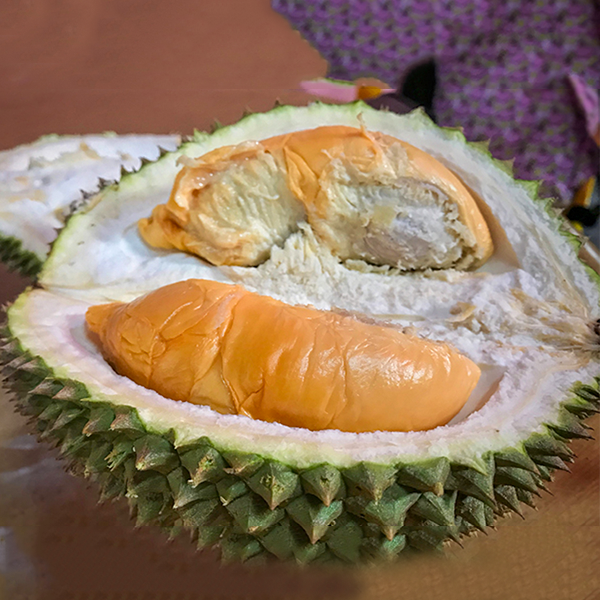Here's The Difference Between D24, Musang King, Black Thorn, XO & Other Durian Types
Which ones are your favourite?
One of the most popular and pricier varieties is the Musang King. It's characterised by its large size, and the creamy and golden-yellow flesh of Musang King is notably rich, smooth, and custard-like in texture.
Musang King durian seeds are typically smaller compared to the seeds of some other durian varieties. However, the size of the seeds can vary.
Flavour: Rich and bittersweet
Texture: Creamy and buttery
2. D24 (Durian Sultan)
Before Musang King became a top pick for durian fans, D24 was a popular option that was slightly more wallet-friendly. It's still a popular choice compared to other premium varieties, and is often used in desserts and pastries.
Flavour: Sweet and mildly bitter
Texture: Creamy and smooth
3. Black Thorn (D200)
A rival to the famous Musang King, Black Thorn has bright yellow and orangey flesh with a custard-like texture. It is not commonly found and can be as pricey, if not more so, than Musang King.
Its name comes from the reddish brown line found along the middle of the durian and the black stamen that comes out from the bottom of its husk.
The flesh is usually plump and wrinkly, making it very easy to tear with the slightest disturbance.
Flavour: Sweet with a hint of bitterness
Texture: Creamy, custardy, and sticky
4. XO
This durian variety is named after the XO liquor because it has a slightly bitter, alcoholic taste resulting from fermentation inside the shell.
According to DuriAddict, XO durian is of higher quality than D24 in terms of age, freshness, and origin. It has also been said that those who consume XO may experience drowsiness after because of the fermentation.
Flavour: Sweet and slightly alcoholic
Texture: Creamy with a hint of firmness
5. Red Prawn (Ang Heh, Udang Merah, Hong Har, Hong Xia, D175)
Unlike other durian varieties, the Red Prawn durian typically features a outer husk with a reddish-brown colour, contributing to its name. The flesh also has a soft, reddish-orange hue and is known for its velvety, rich texture.
It is not as widely available, and due to its popularity and limited availability, it can be relatively pricey.
Flavour: Sweet and creamy
Texture: Soft and fibrous
6. D101
D101 durian is recognised for its pale yellow to golden-yellow flesh, boasting a pleasant balance of sweetness and a creamy consistency. It is often used in desserts, pastries, and ice creams.
Flavour: Sweet aftertaste
Texture: Creamy
7. D15 (Chanee, Penang 15, Juara 90, Butter King, D123, Ganja Durian)
Originating from Thailand, where it is called Chanee, the D15 durian is said to have one of the thickest durian flesh around. It's worth noting that Penang Chanee differs slightly from Thailand's Chanee due to the climate.
Flavour: Sweet with a hint of bitterness, sometimes has an alcoholic taste
Texture: Sticky, not so fibrous
8. Golden Phoenix (Jin Feng)
If you're not a fan of overly sweet durians, the Golden Phoenix has pale, yellow-white flesh and is occasionally known for its slightly bitter taste with a hint of sweetness.
Flavour: Bitter with sweet notes
Texture: Creamy and fibrous
9. Green Skin (D145, Durian Hijau Beserah)
The pride of Berserah Pahang, the Green Skin durian or D145 earned its reputation long before the Musang King. Unfortunately, when the Musang King came into the picture, many D145 trees were replaced by the latter.
Some of these trees are said to be preserved by farmers, although the fruit very rarely makes its way out of Pahang.
Flavour: Mild and sweet
Texture: Creamy and slightly fibrous
10. D13
Often mistaken for the Red Prawn due to the similar colour and shape of the fruitlets, D13 has a soft texture with a thin membrane and generally large seeds.
It's been said if you open the Red Prawn and D13 side by side, it'll be difficult to tell the difference. The pulp is usually reddish-dark orange and slightly sticky.
Flavour: Mild, sweet with a hint of floral vanilla notes
Texture: Creamy, soft, and sticky
11. Black Pearl (Tai Yuan, Tai Guan)
Black Pearl durian flesh typically exhibits a pale yellow colour, distinguishing it from other premium varieties that boast golden yellow or dark orange hues. But don't be fooled by its unassuming colour; it has a rich and complex flavour profile.
Exceptionally rare to come by, the Black Pearl durian is a must-try variety, albeit accompanied by a higher price tag due to its scarcity. It's almost as rare as the Black Thorn and comes with small, pearl-like seeds.
Flavour: Milky, bittersweet
Texture: Smooth and creamy
12. Hor Lor (D163)
For a less sticky and drier flesh, consider the Hor Lor, also known as D163. Renowned for its milder taste, it proves to be an excellent option for beginners or those seeking a well-balanced flavour without an overpowering experience.
Flavour: Sweet and creamy
Texture: Soft and fibrous
13. Black Gold (Empire King)
On a higher tier than the Black Pearl, the Black Gold is a choice tailored for seasoned durian connoisseurs accustomed to intense flavours.
Characterised by its dark-coloured pulp, custard-like smooth texture, and often higher price point, the Black Gold offers a distinctive experience for those who appreciate the nuances of premium durians.
Flavour: Bitter end, intense
Texture: Custardy, smooth
BONUS: Durian Kampung
Durian Kampung, as its name suggests, typically refers to a variety of durian commonly found in traditional or village settings in Malaysia and other Southeast Asian countries.
The taste, size, and texture of Durian Kampung can vary, as it may not belong to a specific cultivar. It could encompass several local varieties or be a way of referring to durians grown in a particular region.
Flavour and texture: Varies depending on the region it was grown






